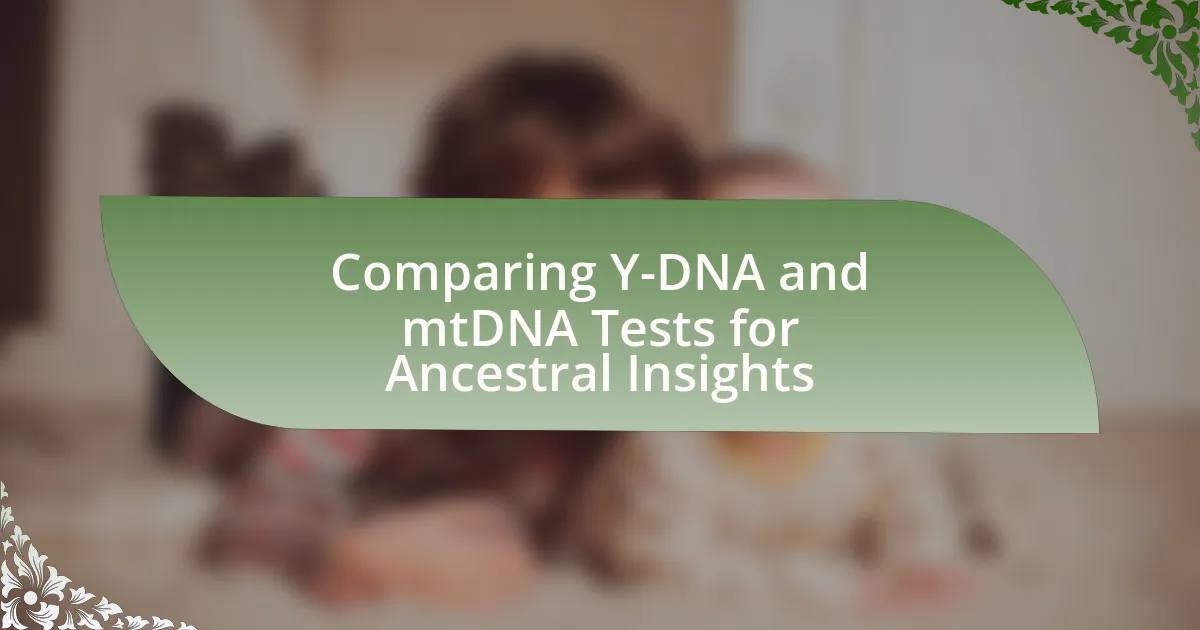Genetic markers in family lineage are specific DNA sequences that serve as unique identifiers for tracing ancestry and familial relationships. This article explores the various types of genetic markers, including single nucleotide polymorphisms (SNPs), short tandem repeats (STRs), and mitochondrial DNA, highlighting their significance in genealogical research and population genetics. It discusses how these markers contribute to understanding lineage, the methods used for their analysis, and their applications in medical genealogy and personalized medicine. Additionally, the article addresses the ethical considerations and challenges associated with genetic data, providing practical steps for individuals interested in exploring their family history through genetic testing.
What are Genetic Markers in Family Lineage?

Genetic markers in family lineage are specific sequences of DNA that can be used to identify individuals and trace ancestry. These markers, which include single nucleotide polymorphisms (SNPs), short tandem repeats (STRs), and mitochondrial DNA, provide unique genetic signatures that can reveal familial relationships and heritage. For instance, SNPs can indicate genetic variations that are inherited from ancestors, while STRs are often used in forensic analysis and paternity testing due to their variability among individuals. The use of these markers has been validated through extensive genetic research, demonstrating their effectiveness in genealogical studies and population genetics.
How do genetic markers contribute to understanding family lineage?
Genetic markers significantly contribute to understanding family lineage by providing unique identifiers that trace ancestry and familial relationships. These markers, which include specific sequences of DNA, can reveal genetic connections between individuals, allowing researchers to construct family trees and identify common ancestors. For instance, mitochondrial DNA is passed down maternally and can be used to trace maternal lineage, while Y-chromosome markers are useful for tracing paternal lineage. Studies have shown that analyzing these genetic markers can uncover historical migration patterns and familial ties that may not be evident through traditional genealogical methods.
What types of genetic markers are commonly used in lineage studies?
Commonly used genetic markers in lineage studies include mitochondrial DNA (mtDNA), Y-chromosome DNA, and autosomal DNA markers. Mitochondrial DNA is inherited maternally and is useful for tracing maternal lineage, while Y-chromosome DNA is passed from father to son, making it ideal for studying paternal lineage. Autosomal DNA markers, which are inherited from both parents, provide a broader view of ancestry and can reveal connections across multiple generations. These markers are validated by their widespread application in genealogical DNA testing and population genetics research, demonstrating their effectiveness in tracing lineage and ancestry.
How do genetic markers differ from other genetic indicators?
Genetic markers are specific sequences in the genome that can be used to identify individuals or species, while other genetic indicators may refer to broader traits or characteristics influenced by multiple genes. Genetic markers, such as single nucleotide polymorphisms (SNPs) or microsatellites, provide precise information about genetic variation and inheritance patterns, making them valuable for tracing lineage and ancestry. In contrast, other genetic indicators, like phenotypic traits, result from the interaction of various genetic and environmental factors, which can complicate their use in lineage studies. This distinction highlights the utility of genetic markers in providing clear, quantifiable data for genealogical research and population genetics.
Why are genetic markers important for genealogical research?
Genetic markers are important for genealogical research because they provide unique identifiers that can trace lineage and ancestry. These markers, which include specific sequences of DNA, allow researchers to establish biological relationships between individuals and populations. For instance, Y-DNA markers are passed from father to son, making them useful for tracing paternal lines, while mitochondrial DNA is inherited from mothers, aiding in maternal lineage studies. Studies have shown that genetic testing can reveal connections to distant relatives and confirm or refute family histories, enhancing the accuracy of genealogical research.
What insights can genetic markers provide about ancestry?
Genetic markers can provide insights into ancestry by revealing an individual’s genetic lineage and ancestral origins. These markers, such as single nucleotide polymorphisms (SNPs) and mitochondrial DNA, can trace lineage back through generations, identifying specific populations and geographic regions from which ancestors may have originated. For instance, studies have shown that certain SNPs are prevalent in specific ethnic groups, allowing researchers to estimate an individual’s ancestral background with a high degree of accuracy. Additionally, mitochondrial DNA is passed down maternally and can be used to trace maternal ancestry, while Y-chromosome markers can trace paternal lineage. This genetic information can help reconstruct family trees and provide a clearer understanding of an individual’s heritage.
How do genetic markers help in tracing lineage over generations?
Genetic markers assist in tracing lineage over generations by providing unique identifiers in an individual’s DNA that can be inherited from ancestors. These markers, such as single nucleotide polymorphisms (SNPs) and short tandem repeats (STRs), allow researchers to compare genetic similarities and differences among individuals, revealing familial connections. For instance, studies have shown that specific genetic markers can be linked to particular ancestral populations, enabling the reconstruction of family trees and the identification of common ancestors. This method has been validated through extensive genetic research, including large-scale genome-wide association studies, which demonstrate how genetic variations correlate with lineage and ancestry.
How are Genetic Markers Analyzed?

Genetic markers are analyzed through various techniques, primarily including polymerase chain reaction (PCR), sequencing, and genotyping. PCR amplifies specific DNA segments, allowing for the identification of genetic variations. Sequencing determines the exact order of nucleotides in a DNA segment, providing detailed information about genetic markers. Genotyping involves assessing the genetic variation at specific loci, often using methods like single nucleotide polymorphism (SNP) analysis. These techniques enable researchers to correlate genetic markers with traits or lineage, facilitating studies in genetics and ancestry.
What methods are used to analyze genetic markers?
Methods used to analyze genetic markers include polymerase chain reaction (PCR), DNA sequencing, and genotyping. PCR amplifies specific DNA sequences, allowing for detailed examination of genetic variations. DNA sequencing determines the exact order of nucleotides in a DNA segment, providing comprehensive insights into genetic information. Genotyping identifies specific alleles at particular loci, enabling researchers to assess genetic diversity and lineage relationships. These methods are widely validated in genetic research, with PCR being a foundational technique since its development in the 1980s, and DNA sequencing technologies evolving significantly, such as the introduction of next-generation sequencing in the early 2000s.
How does DNA sequencing contribute to genetic marker analysis?
DNA sequencing significantly enhances genetic marker analysis by providing precise information about the nucleotide sequences that define genetic variations. This technology allows researchers to identify specific genetic markers associated with traits or diseases by comparing sequences across individuals. For instance, high-throughput sequencing methods can analyze thousands of genetic markers simultaneously, enabling comprehensive studies of genetic diversity and inheritance patterns. The accuracy of DNA sequencing ensures that the identified markers are reliable, which is crucial for applications in genealogy, population genetics, and personalized medicine.
What role do bioinformatics play in analyzing genetic markers?
Bioinformatics plays a crucial role in analyzing genetic markers by providing computational tools and methods to interpret complex biological data. These tools enable researchers to identify, compare, and visualize genetic variations across different individuals or populations, facilitating the understanding of inheritance patterns and lineage relationships. For instance, bioinformatics algorithms can process large genomic datasets to pinpoint single nucleotide polymorphisms (SNPs) and other markers that are essential for tracing ancestry and familial connections. The integration of bioinformatics in genetic analysis has been validated by studies demonstrating its effectiveness in mapping genetic traits and understanding population genetics, such as the research published in “Nature Reviews Genetics” by Durbin et al., which highlights the importance of computational approaches in modern genetic research.
What challenges are faced in the analysis of genetic markers?
The analysis of genetic markers faces several challenges, including genetic variability, data interpretation complexities, and ethical considerations. Genetic variability can lead to difficulties in identifying consistent markers across different populations, as variations may affect the reliability of results. Additionally, the interpretation of data is complicated by the presence of background noise and the need for sophisticated statistical methods to distinguish true signals from random fluctuations. Ethical considerations, such as privacy concerns and the implications of genetic information, further complicate the analysis process, necessitating careful handling of sensitive data.
How can errors in genetic data affect lineage conclusions?
Errors in genetic data can lead to incorrect lineage conclusions by misrepresenting ancestral relationships. For instance, inaccuracies in DNA sequencing or sample contamination can result in false positives or negatives in genetic markers, which are crucial for tracing lineage. A study published in the journal “Nature” by Wang et al. (2020) demonstrated that even minor errors in genetic data could significantly alter the perceived connections between individuals in a family tree, leading to misleading interpretations of ancestry. Therefore, the reliability of lineage conclusions heavily depends on the accuracy of the underlying genetic data.
What are the limitations of current genetic marker analysis techniques?
Current genetic marker analysis techniques face several limitations, including issues with resolution, cost, and interpretability. For instance, many techniques, such as single nucleotide polymorphism (SNP) analysis, may not capture the full complexity of genetic variation, leading to incomplete or misleading results. Additionally, high-throughput sequencing methods can be prohibitively expensive, limiting their accessibility for widespread use. Furthermore, the interpretation of genetic data often requires extensive bioinformatics expertise, which can create barriers for researchers and clinicians who lack this specialized knowledge. These limitations hinder the effectiveness and applicability of genetic marker analysis in understanding family lineage.
What are the Applications of Genetic Markers in Family Lineage?

Genetic markers are utilized in family lineage applications primarily for ancestry tracing, genetic disease risk assessment, and genealogical research. These markers, which include single nucleotide polymorphisms (SNPs) and short tandem repeats (STRs), help identify hereditary traits and lineage connections. For instance, SNP analysis can reveal genetic predispositions to certain diseases, allowing families to understand potential health risks that may be inherited. Additionally, STRs are often used in genealogical DNA testing to establish familial relationships and confirm paternity or maternity, providing concrete evidence of lineage connections. Studies have shown that genetic testing can accurately trace lineage back several generations, enhancing our understanding of family history and genetic heritage.
How can genetic markers assist in medical genealogy?
Genetic markers assist in medical genealogy by providing insights into hereditary health conditions and traits within families. These markers, which can be specific sequences of DNA, help identify genetic predispositions to diseases such as cancer, diabetes, and heart disease. For instance, the BRCA1 and BRCA2 gene mutations are well-documented markers associated with an increased risk of breast and ovarian cancer, allowing families to understand their risk factors and make informed health decisions. By analyzing these genetic markers, individuals can trace their lineage and uncover potential health risks that may have been passed down through generations, thereby enhancing preventive healthcare strategies.
What diseases can be traced through genetic markers?
Diseases that can be traced through genetic markers include cystic fibrosis, sickle cell anemia, Huntington’s disease, and certain types of cancer such as breast and ovarian cancer linked to BRCA1 and BRCA2 mutations. Genetic markers are specific sequences in DNA that can indicate a predisposition to these conditions. For instance, the presence of mutations in the CFTR gene is associated with cystic fibrosis, while mutations in the HTT gene are linked to Huntington’s disease. Studies have shown that identifying these genetic markers can significantly aid in early diagnosis and management of these diseases, thereby improving patient outcomes.
How do genetic markers inform personalized medicine approaches?
Genetic markers inform personalized medicine approaches by providing specific information about an individual’s genetic predispositions to diseases and responses to treatments. These markers, which can include single nucleotide polymorphisms (SNPs) and other variations, enable healthcare providers to tailor medical interventions based on a patient’s unique genetic profile. For instance, studies have shown that certain genetic markers can predict how well a patient will respond to specific medications, such as in the case of pharmacogenomics, where variations in genes like CYP2D6 influence drug metabolism. This targeted approach enhances treatment efficacy and minimizes adverse effects, ultimately leading to improved patient outcomes.
What ethical considerations arise from using genetic markers?
The ethical considerations arising from using genetic markers include privacy concerns, potential discrimination, and informed consent. Privacy concerns stem from the risk of unauthorized access to sensitive genetic information, which could lead to misuse by employers or insurance companies. Discrimination may occur if individuals are treated unfairly based on their genetic predispositions, as seen in cases where genetic data influences hiring or insurance decisions. Informed consent is crucial, as individuals must fully understand the implications of genetic testing and how their data will be used, ensuring they are not coerced into testing without adequate knowledge of potential consequences. These considerations highlight the need for robust ethical guidelines and regulations in the use of genetic markers.
How is privacy maintained when using genetic data for lineage studies?
Privacy is maintained when using genetic data for lineage studies through techniques such as data anonymization, informed consent, and secure data storage. Data anonymization involves removing personally identifiable information from genetic datasets, ensuring that individuals cannot be easily identified. Informed consent requires researchers to obtain explicit permission from participants, detailing how their genetic data will be used and ensuring they understand the implications. Secure data storage practices, including encryption and restricted access, further protect genetic information from unauthorized access. These measures collectively uphold privacy while allowing for valuable insights into family lineage.
What are the implications of genetic findings on family dynamics?
Genetic findings significantly impact family dynamics by influencing relationships, identity, and health awareness. For instance, the discovery of genetic predispositions to certain diseases can lead to increased communication among family members about health risks, fostering a supportive environment. Additionally, genetic testing can reveal previously unknown familial connections, which may alter perceptions of family identity and belonging. Research indicates that understanding genetic markers can enhance family cohesion by promoting discussions about shared traits and health histories, ultimately strengthening familial bonds.
What practical steps can individuals take to explore their family lineage using genetic markers?
Individuals can explore their family lineage using genetic markers by first selecting a reputable genetic testing service that offers ancestry DNA tests. After obtaining a DNA sample, typically through a saliva or cheek swab, individuals send it to the testing company for analysis. The results will provide insights into ethnic backgrounds, potential relatives, and genetic traits linked to ancestry.
To further understand the lineage, individuals can compare their results with those of relatives who have also undergone testing, which can reveal shared genetic markers and connections. Additionally, utilizing online platforms that aggregate genetic data can help individuals connect with distant relatives and build a family tree based on genetic matches.
Research indicates that genetic testing can uncover ancestral origins and familial connections that traditional genealogical methods may not reveal, making it a valuable tool for lineage exploration.
How can one choose the right genetic testing service for lineage research?
To choose the right genetic testing service for lineage research, one should evaluate the company’s reputation, the types of tests offered, and the accuracy of their results. Reputable services often have positive customer reviews and are backed by scientific research. For lineage research, look for companies that provide Y-DNA and mtDNA testing, as these tests specifically trace paternal and maternal lines, respectively. Additionally, consider the database size; larger databases can enhance the likelihood of finding matches. Services like AncestryDNA and 23andMe are well-regarded for their comprehensive offerings and user-friendly interfaces, making them suitable options for lineage research.
What are best practices for interpreting genetic marker results?
Best practices for interpreting genetic marker results include consulting with a qualified genetic counselor or specialist to ensure accurate understanding and context. Genetic markers can indicate predispositions to certain traits or conditions, but their interpretation requires knowledge of genetic variation, population genetics, and the specific markers involved. It is essential to consider the individual’s family history and the potential for environmental factors to influence genetic expression. Additionally, utilizing reputable databases and resources, such as the National Center for Biotechnology Information, can provide context for the significance of specific markers. This approach ensures that interpretations are grounded in scientific evidence and tailored to the individual’s unique genetic background.




